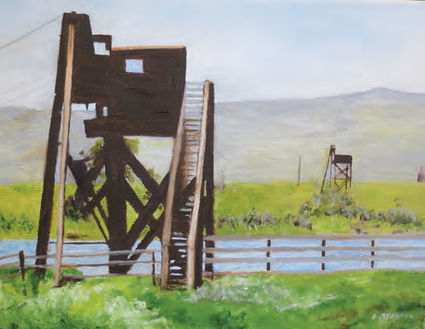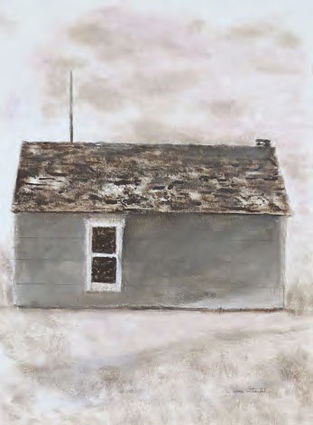Schools and Education in Montana (Part 4)
November 27, 2019
Our own little Roundup, which reckons itself a town from 1908, has its own history of both Catholic and public education.
The Roundup Museum has an informative map covering the 1920s to the 1950s. In the region of the River's crossing the county, it itemizes 88 public schools, mainly one-room, rural affairs and 66 ranches.
Originally, those wishing to attend public high school came to Roundup, exemplified in our last article by the 80-year-old that recounts walking 14 miles home each weekend to see his family. The County high school building was the Community Center, as it is still called, is another example of a school intended to serve the public at large. Later, beginning about 100 years ago, the Central School contained all the grades through high school.
Pictured here is one of the prairie schools. We have no history of this one-room building other than the log walls were covered with tar paper and the shingles on one-half the roof were covered with tin. It sat silently, decaying in the middle of the High Plains, near Big Wall Road. When the young couple bought their ranch so many years ago, they were unable to discover more facts, though a few times different vehicles would drive down Big Wall, stop, older folks and perhaps others would stand and stare at what must have been their childhood school, and talk. Then they drove away, but as the years passed, the oldsters stopped coming. Finally, the ranchers sold the building to their neighbor who hauled it away, kept it vacant a few years, then, with a few alterations, turned it into a chicken coup.
Until 1912 there was no Catholic Church in Roundup, much less a school, though Masses were held wherever space could be found, such as in today's Masonic Hall.
The opening of coal mines in the vicinity in 1907-08 attracted hundreds of European immigrants, predominantly Catholics wanting their children to be educated in that faith. Therefore, as early as 1919 work to establish a parochial school began, and in 1921 five nuns, Sisters of Holy Humility of Mary, came to Roundup from Nevada and opened school in the church basement. The nuns had come for the purpose of establishing a hospital, not a school, and when obstacles to that mission arose, they departed the town – after just a single school term.
Seed funding for a school was provided by twenty parishioners, each loaning $500 to the Diocese. The building, designed by Roundup architect, John Grant, was completed in autumn, 1921, cost $31,000, and functions today as our museum.
In 1922 it was the Ursuline nuns that came to Roundup's rescue, too. They opened with 123 students in eight grades and four classrooms. The nuns and boarding students from rural homes lived in the basement. St. Benedict's second pastor, Father Hennessy, resolved to provide Catholic education through high school.
The Ursulines taught until 1933, when they were replaced by the Sisters of Charity of Providence, who gave way later to the Sisters of the Holy Family of Nazareth, who left in 1950. At that point, no other religious could be found to staff the school, and it closed, a very short tenure for the expensive and beautiful structure"." True, we have mentioned innovative Montanan schemes for transporting children to schools, but we saved the real surprise as our final their livestock were ten children!
When Dan passed away in 1931, the four eldest sons, already operating their own ranches, inherited the property, which became Susan Haughian and Sons, and merged their own cattle with hers. Later the business became the Haughian Livestock Company and was eventually partitioned back again into four parts.
Daniel, the first son, nearly matched his parents with nine children, and his brother, living next door, so to speak, had six, and schooling their broods, along with children belonging to hired hands, was a significant problem. To the parents in these years, school was a serious business, because subsisting was a struggle. They had dropped out during grade school and would not accept that for their children.
At first, the best solution was to establish their own institution, so the families hired a teacher and populated their own, country school. This throve, until the little building burned, thus throwing the problem back upon them.
The Milwaukee Railroad had bridges over the sinuous Yellowstone, but automobile tires were a poor fit for the tracks. As circumstances stood, it was a one hour drive to Miles City and two hours to Terry. Because school funding is very much a function of enrollment, Terry was keenly interested in adding these 15+ students, so when the Haughians decided to construct a passage across the river, the County contributed to the cost and work, under the agreement that there would be public access to the system.
The Haughian Trans-Yellowstone Aerial Tramway (our name) went into operation in 1961. Originally, control of the electric car was built into the stations at both terminals, but the far side system failed, so through most of its life the tram was controllable only at the home side. Initially, there was also a telephone connection between sides, so that children wanting to return could phone their readiness. That communication link also failed, so on the far side they installed a horn to honk for service, but, mainly, someone had to be on hand at the home side to watch for returning children. After cruising over the river, the students climbed a fence, hiked across a field, and caught a school bus.
The line across the river was 1/3 mile, which distance the car covered in 3.5 minutes, which translates into a velocity of about 10 mph. The car had no brake, so the trick was to cut power when approaching the substation and coast in gently. Yellow markers were painted on the cable to allow an operator to know when to punch "stop," but ice and snow could obliterate the painted guides and make landings a little rough.
Naturally, the regular tram scholars teased any friends that might ride with them and do their best to frighten the newcomers. In particular, at one time the worn cable required splicing, and when the car passed over that point, a noticeable shock ran through it. The Haughians prank was to feign surprise and fear at this bump, so as to terrify the unfamiliar passengers.
Speaking of ice and snow, we learned that the tram operated the year round, but the scholars had an alternate route, too. Colder winters at that time caused the Yellowstone to freeze more solidly than at present, and one of the adults would scout a safe path across the ice and mark it with pegs, so that the children, from the early grades into high school age, could follow it.
Summer weather posed a different problem; temperatures inside the metal car became oppressive, so the glass windows were removed for comfort. This attests to the maturity of the young passengers, for the missing windows presented spaces through which they could climb and potentially fall into the river. Given a little freedom, children have been known to grow dangerously adventuresome, but this group always acted responsibly, aside from tossing occasional small objects into the water below.
In 1985-86 the railroad ceased operations in those parts, and their bridges could be reworked to accommodate vehicular traffic. With that, the drive to their Terry school was greatly diminished, and the tram became unnecessary, but what a glorious quarter-century of school transportation The Flying Susan provided!
2014 wrote the final episode in the career of the magnificent invention. An ice storm and a frozen Yellowstone cut the lower cable, and there was no incentive at that date to undertake repairs. The painting shows the system as we found it in 2007.








Reader Comments(0)